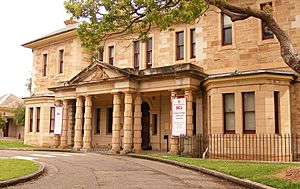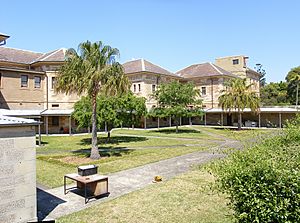Callan Park Hospital for the Insane facts for kids
Quick facts for kids Callan Park Hospital for the Insane |
|
|---|---|

General view of the former hospital
|
|
| Geography | |
| Location | Lilyfield, New South Wales, Australia |
| Coordinates | 33°51′57″S 151°09′44″E / 33.8659°S 151.1623°E |
| Organisation | |
| Hospital type | Disused mental hospital |
| Services | |
| History | |
| Founded | 1878 |
| Closed | April 2008 (as Rozelle Hospital) |
The Callan Park Hospital for the Insane was a special hospital in Lilyfield, Sydney, Australia. It was built on the beautiful shores of Iron Cove and opened in 1878. Over the years, its name changed several times. It was known as the Callan Park Mental Hospital from 1915 to 1976. Then it became Callan Park Hospital until 1994. Finally, it was called Rozelle Hospital until it closed in 2008.
After it closed, all its services and patients moved to Concord Hospital. Today, the site is protected. Its future uses are limited to health, education, and community activities. The Government of New South Wales still owns the land. They work with the local council to manage it. The goal is for it to be a "wellness sanctuary."
Currently, parts of the site are used by the Sydney College of the Arts. Writing NSW (a group for writers) and the New South Wales Ambulance headquarters are also located there. The buildings are made of sandstone. They were designed by famous architects like James Barnet and Mortimer Lewis. The beautiful gardens were planned by botanist Charles Moore. The entire site was added to the New South Wales State Heritage Register on April 2, 1999. This means it's a very important historical place.
Contents
A Look Back: The Hospital's History
Early Days: From Indigenous Land to Estates
Before Europeans arrived, the Wangal people lived here. They were part of the Eora or Dharug tribes. Their land stretched along the Parramatta River. Sadly, many Indigenous people were affected by smallpox and European settlement.
The first European settlers received land grants between 1789 and 1821. Two grants, "Fairlight" and another, became the Garry Owen estate. This estate later became known as Callan Park. Another nearby estate was called Austenham. Broughton Hall, a large house built in the 1840s, was on this estate. It later became a separate psychiatric clinic. Eventually, Broughton Hall and Callan Park Hospital joined together.
Garry Owen House was built around 1839 for Ryan Brenan. He was the estate's owner. The house was likely designed by Colonial Architect Mortimer Lewis. It was a grand home with beautiful gates and gardens. Brenan sold the estate in the 1860s to John Gordon. Gordon renamed it Callan Park.
Building the Hospital: A New Approach to Care
In 1873, the government bought the Callan Park site. They wanted to build a large hospital for people with mental health issues. This was because the Gladesville Hospital was very crowded. The new hospital was designed based on ideas from Dr. Thomas Kirkbride of America. His ideas focused on creating a healing environment.
Charles Moore, who directed the Botanic Gardens, designed the hospital's grounds. Garry Owen House was changed to be part of the hospital in 1875. Colonial Architect James Barnet worked with Dr. Frederick Norton Manning. They designed twenty new buildings in the neo-classical style. These buildings were finished in 1885 and called the Kirkbride Block.
Over time, the hospital's entrance and gardens were changed. During World War I, more facilities were built. This was because mental health care changed, and more people were admitted to large hospitals.
A Doctor's Work and Hospital Mergers
Dr. Harry Richard Bailey was a psychiatrist who worked at Broughton Hall Psychiatric Clinic in 1952. He later became assistant director of psychiatric clinical services. He studied new ways to treat mental illness, including different therapies. In 1957, the Cerebral Surgery and Research Unit was set up at Callan Park Mental Hospital, and Dr. Bailey became its director. He explored new methods for treating mental health conditions.
In 1976, Callan Park Hospital merged with the nearby Broughton Hall Psychiatric Clinic. This new combined hospital was named Rozelle Hospital.
Moving Towards Community Care
The Kirkbride complex was used to house and treat patients until 1994. After that, services moved to other buildings on the Callan Park grounds. Many patients also moved into homes in the community. This was part of a government plan to provide care outside of large institutions.
In 2007, there were talks about the University of Sydney using the Callan Park site. However, local community groups strongly disagreed. By 2008, the government decided against the university's plans. Instead, a large part of the site was given to the local council.
What's There Now: Current Uses
The beautiful parklands at Callan Park are open to everyone. People can visit and enjoy them. A special law, the Callan Park (Special Provisions) Act 2002, guides how the site can be used. It says the site must be used for health, education, and community activities that are not for profit. Making money from the site is not allowed.
After a lot of restoration work, the Kirkbride Complex is now home to the Sydney College of the Arts. This is the fine arts campus of the University of Sydney. Other groups using the site include Writing NSW and the New South Wales Ambulance headquarters.
In 2011, the local council and a group called "Friends of Callan Park" presented a plan for the site. In 2015, the New South Wales Parliament approved this plan. They agreed to create a special trust to manage the site. This trust would help protect Callan Park for the future. It would include people representing Indigenous owners, government, local council, mental health consumers, and other groups.
Exploring the Site: Buildings and Gardens
The Rozelle Hospital site covers 61 hectares (about 150 acres). It has rolling parkland along the waterfront. You can find many historic buildings and different types of gardens there. The site holds a rich history, from Aboriginal heritage to its time as a hospital.
It has many important heritage buildings. These include two of the original houses from the 1800s. The amazing Kirkbride Block, finished in 1885, is also there. It was built for the Callan Park Psychiatric Hospital. Now, it's the campus for the Sydney College of the Arts.
Garry Owen House: Now Writing NSW
This was the first building on the site, built around 1840. It sits on a raised area with great views over Iron Cove. It was once a grand private home. It still has some of its original garden design. You can see old trees like a Southern magnolia and camellias. There are also jacaranda trees and cabbage tree palms.
The house has two main rooms that could open up to form a large ballroom. This was similar to Government House in Sydney. The building shows the style of architect Mortimer Lewis. The verandahs have unique octagonal paving blocks, a special touch by James Barnet.
Garry Owen Cottage: For Patients
This cottage was designed by James Barnet in the 1880s. It was built for male patients who were recovering. It's made of sandstone. This cottage, along with other convalescent cottages, was part of the beautiful setting around the Kirkbride Block.
The Kirkbride Complex: A Grand Design
The Kirkbride complex stands on a high ridge. It's a magnificent group of sandstone buildings and courtyards. It was finished in 1885 for the Callan Park Psychiatric Hospital. This complex is now used by the Sydney College of the Arts.
Why Callan Park is Special: Heritage Listing
On April 2, 2017, the Callan Park area and its buildings were officially listed on the New South Wales State Heritage Register. This means it's very important for its history, culture, and beauty.
The site is valued by the community as a public space. The Kirkbride Block is important because it was designed by three famous people: James Barnet, Charles Moore, and Frederick Norton Manning. It was the largest mental institution in New South Wales at the time. It was also the first to be designed as a place for healing. The landscape and gardens were a key part of this healing idea. They were designed to help patients feel better. It's amazing that so much of the original design is still there, even in a busy city area.
Garry Owen House is also very important. It's one of the oldest houses in the area. It shows the early history of Rozelle. The hospital grounds themselves are historically significant. They show how mental health care changed in New South Wales. The grounds also show how patients were involved in their care.
Callan Park in Popular Culture
Callan Park has appeared in many films and TV shows:
- It was featured in the 1996 Australian film Cosi.
- The novel Jessica by Bryce Courtenay mentions the main character being in the asylum.
- The 2008 film The Last Confession of Alexander Pearce filmed scenes in the old asylum's tunnels.
- The music video for Ricki-Lee's song "Crazy" was filmed there in 2012.
- The TV series Love Child and Doctor Doctor filmed scenes at the hospital.
- The films Bliss and Ravenswood also used the hospital as a filming location.
People Connected to Callan Park
Notable Patients
- J. F. Archibald: He was the editor of The Bulletin magazine.
- William James Chidley: A social reformer.
- Louisa Lawson: A famous Australian who fought for women's right to vote. She was the mother of poet Henry Lawson.
- Bea Miles: An eccentric and well-known person in Sydney.
Notable Staff
- Harry Richard Bailey: A psychiatrist who worked at the hospital.
- Lillian May Armfield: A pioneering female police detective in Sydney. She worked as a nurse at Callan Park before becoming a police officer.
- Graeme Revell: A well-known film composer. He worked as a nurse at the facility in the late 1970s.




